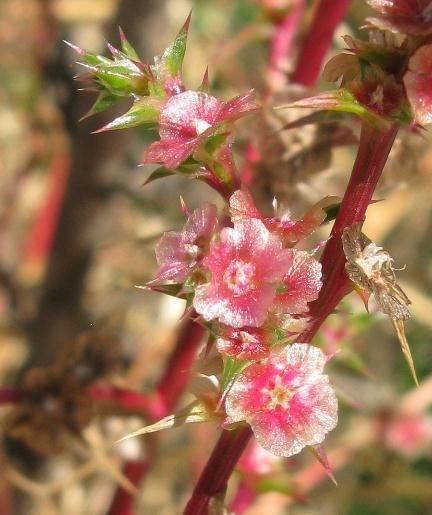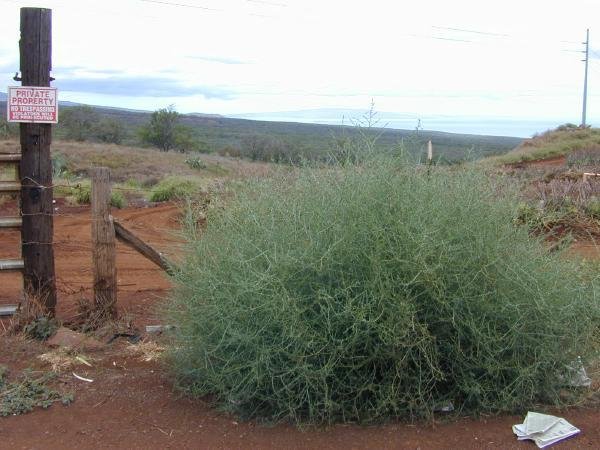





We've all seen the movies and television shows. Rickety wooden buildings line a deserted street. A slight breeze kicks up some dust and a tumbleweed rolls across a side street. Tumbleweeds are iconic symbols of the American West. However, tumbleweeds are not native to the West, but to Eurasia.
Tumbleweeds of the genus Salsola are also known as Russian thistle. (Some flora list the genus as Kali.) Though they are not true thistles, their prickly form suggests their namesake. Tumbleweeds were accidentally introduced into the United States with flax seed imported from Russia to South Dakota in the 1870s. The plant spread farther by contaminated seed stock, threshing crews, and livestock cars. It has invaded about 100 million acres in the American West and it is particularly well-adapted to the climates and conditions found in California. However, one species or another of Salsola has spread to every state except Alaska and all Canadian provinces except the Yukon Territory, Northwest Territories, and Nunavut. The genus has also become naturalized in Central and South America.
Tumbleweeds are globular, shrub-like annuals up to six feet tall. After the plant dies and dries out, the stem breaks off at ground level and the plant is blown along by the wind, scattering tens of thousands of seeds as it goes. Other unrelated plants that exhibit this same behavior are also sometimes called tumbleweeds.
In general, tumbleweeds grow in disturbed areas, like plowed fields, burned areas, overgrazed land, vacant lots, fence rows, and roadsides. They are most often found in arid and semi-arid climates. The name Salsola means "salty" and the plant is tolerant of salty soils.

The papery appendages are sepals on these tumbleweed fruits
Tumbleweeds are officially listed as noxious weeds in Arkansas, California, Hawaii, and Ohio. Besides competing with cultivated and native plants, tumbleweeds are also a fire hazard. Salsola species are an alternate host for the beet leafhopper which can spread the curly top virus to beets, tomatoes, beans, melons, and other crops. A diet high in tumbleweed can be toxic to livestock, especially sheep. It is the oxalates in the plant that make it toxic. Tumbleweeds are controlled by cutting or pulling the plants before they can go to seed. This should be done every year until the short-lived seed bank is depleted.

Tumbleweed in habitat
Photograph produced by the U.S. Geological Survey
However, tumbleweeds are not without redeeming qualities. In moderate amounts, tumbleweeds are nutritious food for livestock. One DG member reported that she used tumbleweeds to improve her hardpan soil. The tumbleweed roots penetrated the hardpan layer, allowing nutrients and water to travel freely. She cut down the tumbleweeds before they could go to seed and mulched with them and had the best bean crop ever.
Tumbleweeds even have medicinal properties. Salsola tragus has been used in European folk medicine as a treatment for worms, constipation, and as a diuretic. Extracts from the plant have experimentally been shown to lower blood pressure and to have smooth-muscle relaxing effects. In Chinese medicine, Salsola collina is used for hypertension and headaches.
Tumbleweeds are in the Amaranthaceae (Pigweed Family)[1]. This puts them in the same plant family as beets and spinach. Surprisingly, tumbleweeds are edible. Tender young plants, two to three inches tall, can be steamed and eaten with butter and lemon juice. For recipes of tumbleweed casserole and jellied tumbleweed salad, see The Tumbleweed Gourmet[2].
Tumbleweeds have even been used as holiday decorations. In lean times, they have been used as Christmas trees. In places without snow, three tumbleweeds of graduated sizes can be spray painted white and stacked and staked on top of each other to form a "snowman".
Good, bad, or indifferent, this Russian immigrant is here to stay. Like human western pioneers, tumbleweeds are rugged survivors. Perhaps it is appropriate that they are a symbol of the American West.
[1] Some flora place Salsola in the Chenopodiaceae but the Chenopodiaceae have since been placed in the Amaranthaceae.
[2] Niethammer, Carolyn J., The Tumbleweed Gourmet: Cooking with Wild Southwestern Plants, The University of Arizona Press, 1987
Copyright © www.100flowers.win Botanic Garden All Rights Reserved